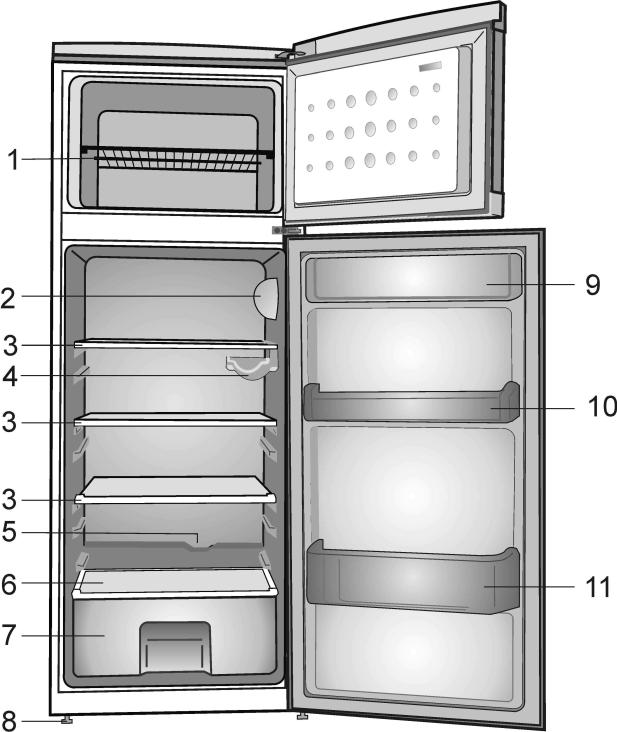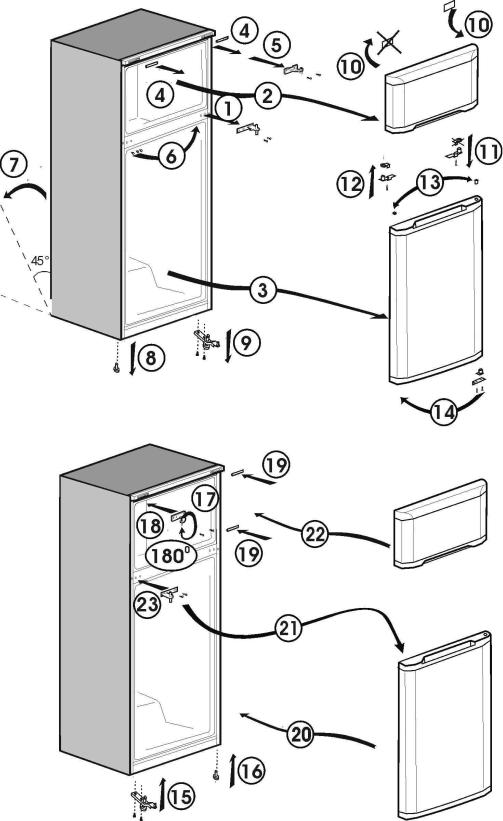Beko DSA 25020 S User Manual [de, it, en]

DSA25020S
GB
IT
D
Instruction for use
Istruzioni per l'uso
Gebrauchsanweisung

WARNING!
In order to ensure a normal operation of your refrigerating appliance, which uses a completely environmentally friendly refrigerant the R 600a (flammable only under certain conditions) you must observe the folloving rules:
Do not hinder the free circulation of the air around the appliance.
Do not use mechanic devices in order to accelerate the defrosting, others than the ones recommended by the manufacturer.
Do not destroy the refrigerating circuit.
Do not use electric appliances inside the food beeping compartment, others than those that might have been reccommended by the manufacturer.
AVVERTENZA!
Per garantire il funzionamento adeguato dell'elettrodomestico, che utilizza il refrigerante R 600a completamente adatto all'ambiente (infiammabile solo in determinate condizioni), è necessario attenersi alle seguenti regole:
Non ostacolare la libera circolazione dell'aria attorno all'elettrodomestico.
Per accelerare lo sbrinamento non utilizzare dispositivi meccanici diversi da quelli consigliati dal produttore.
Non danneggiare il circuito refrigerante.
Non utilizzare all'interno del comparto del cibo elettrodomestici diversi da quelli consigliati dal produttore.
WARNUNG!
Ihr Gerät verwendet ein umweltverträgliches Kältemittel, R 600a (nur unter bestimmten Umständen brennbar). Um einen einwandfreien Betrieb Ihres Gerätes sicherzustellen, beachten Sie bitte folgende Vorschriften:
Die Luftzirkulation um das Gerät darf nicht behindert sein.
Verwenden Sie außer der vom Hersteller empfohlenen, keine mechanischen Hilfsmittel, um den Abtauprozess zu beschleunigen.
Der Kältemittelkreislauf darf nicht beschädigt werden.
Verwenden Sie im Lebensmittelaufbewahrungsbereich Ihres Gerätes keine elektrischen Geräte, es sei denn, sie sind vom Hersteller empfohlen.

GB Index
Safety first /1
Electrical requirements /2 Transportation instructions /2 Installation instructions /2 Getting to know your appliance /3
Suggested arrangement of food in the appliance /3 Temperature control and adjustment /4
Before operating /4 Storing frozen food /4 Freezing fresh food /4 Making ice cubes /5 Defrosting /5
Replacing the interior light bulb /6 Cleaning and care /6 Repositioning the door /6
Do’s and don’ts /7 Trouble – shooting /8 Tehnical data /8
IT Indice
Sicurezza iniziale /9 Requisiti elettrici /10 Istruzioni per il trasporto /10 Istruzioni di installazione /10
Conoscere l’elettrodomestico /11
Suggerimenti sulla disposizione del cibo nell'elettrodomestico /11 Controllo e regolazione della temperatura /11
Prima della messa in funzione /12 Conservazione di cibo congelato /12 Congelamento di cibo fresco /12 Preparazione dei cubetti di ghiaccio /12 Sbrinamento /12
Sostituzione della lampadina interna /13 Pulizia e manutenzione /13 Riposizionamento dello sportello /14 Cosa fare e cosa non fare /14 Risoluzione dei problemi /15
Date tecnici /15
D Inhalt
Sicherheit an erster Stelle /16 Voraussetzungen für den Elektroanschluss /17 Transportvorschriften /17
Hinweise zur Installation und zum Aufstellungsort /17 Kennenlernen des geräts /18
Vorschläge für das einordnen von Lebensmitteln /18 Einstellung und Regelung der Temperatur /19 Inbetriebnahme /19
Lagerung von Tiefkühlware /20 Einfrieren von frischen Lebensmitteln /20
Lebensmittelsymbole und Gefrierkalender /20 Herstellung von Eiswürfeln /20
Abtauen /20
Auswechseln der Glühlampe für die Innenbeleuchtung /21 Reinigung und Pflege /21
Wechseln des türanschlags /22
Was Sie tun sollten und was auf keinen fall-einige hinweise /22 Massnahmen bei Betriebst runger /23
Hinweise zu Betriebsgerauschen /23 Technische angaben /24

1

2
3 |
4 |
5 |
6 |
|

7

GB |
Instruction for use |
|
|
Congratulations on your choice of a  Quality
Quality
Appliance, designed to give you many years of service.
Safety first!
Do not connect your appliance to the electricity supply until all packing and transit protectors have been removed.
•Leave to stand for at least 4 hours before switching on, to allow compressor oil to settle, if transported horizontally.
•If you are discarding an old appliance with a lock or latch fitted to the door, ensure that it is left in a safe condition to prevent the entrapment of children.
•This appliance must only be used for its intended purpose.
•Do not dispose of the appliance on a fire. Your appliance contains non CFC substances in the insulation which are flammable. We suggest you contact your local authority for information on disposal and available facilities.
•We do not recommend use of this appliance in an unheated, cold room. (e.g. garage, conservatory, annex, shed, out-house etc.)
To obtain the best possible performance and trouble free operation from your appliance it is very important to read these instructions carefully. Failure to observe these instructions may invalidate your right to free service during the guarantee period.
Please keep these instructions in a safe place for easy reference.
This appliance is not intended for use by person with reduced physical, sensory or mental capabilities or lack of experience and knowledge unless they have been given supervision or instruction concerning use of the appliance by a person responsible for their safety.
Children should be supervised to ensure that they do not play with the appliance.
1
GB |
Instruction for use |
|
|
Electrical requirements
Before inserting the plug into the wall socket make sure that the voltage and the frequency shown in the rating plate inside the appliance corresponds to your electricity supply.
We recommend that this appliance is connected to the mains supply via a suitably switched and fused socket in a readily accessible position.
Warning! This appliance must be earthed.
Repairs to electrical equipment should only be performed by a qualified technician. Incorrect repairs carried out by an unqualified person are carry risks that may have critical consequences for the user of the appliance.
ATTENTION!
This appliance operates with R 600a which is an environmental friendly but flammable gas. During the transportation and fixing of the product, care must be taken not to damage the cooling system. If the cooling system is damaged and there is a gas leakage from the system, keep the product away from open flame sources and ventilate the room for a while.
WARNING - Do not use mechanical devices or other means to accelerate the defrosting process, others than those recommended by the manufacturer.
WARNING - Do not damage the refrigerant circuit.
WARNING - Do not use electrical appliances inside the food storage compartments of the appliance, unless they are of the type recommended by the manufacturer.
Transportation instructions
1.The appliance should be transported only in an upright position. The packing as supplied must be intact during transportation.
2.If during the transport the appliance, has been positioned horizontally, it must not be operated for at least 4 hours, to allow the system to settle.
3.Failure to comply with the above instructions could result in damage to the appliance, for which the manufacturer will not be held liable.
4.The appliance must be protected against rain, moisture and other atmospheric influences.
Important!
•Care must be taken while cleaning/carrying the appliance not to touch the bottom of the condenser metal wires at the back of the appliance, as this could cause injury to fingers and hands.
•Do not attempt to sit or stand on top of your appliance as it is not designed for such use. You could injure yourself or damage the appliance.
•Make sure that the mains cable is not caught under the appliance during and after moving, as this could damage the cable.
•Do not allow children to play with the appliance or tamper with the controls.
Installation instructions
1.Do not keep your appliance in a room where the temperature is likely to fall below 10 degrees C (50 degrees F) at night and/or especially in winter, as it is designed to operate in ambient temperatures between +10 and +32 degrees C (50 and 90 degrees F). At lower temperatures the appliance may not operate, resulting in a reduction in the storage life of the food.
2.Do not place the appliance near cookers or radiators or in direct sunlight, as this will cause extra strain on the appliance's functions. If installed next to a source of heat or freezer, maintain the following minimum side clearances:
From Cookers 30 mm From Radiators 300 mm From Freezers 25 mm
3.Make sure that sufficient room is provided around the appliance to ensure free air circulation (Item 2).
• Put the back airing lid to the back of your refrigerator to set the distance between the
refrigerator and the wall (Item 3).
2
GB |
Instruction for use |
|
|
4.The appliance should be positioned on a smooth surface. The two front feet can be adjusted as required.To ensure that your appliance is standing upright adjust the two front feet by turning clockwise or anticlockwise, until firm contact is secured with the floor. Correct adjustment of feet prevents excessive vibration and noise (Item 4).
5.Refer to "Cleaning and Care" section to prepare your appliance for use.
Getting to know your appliance
(Item 1)
1 - Freezer shelf
2 - Thermostat and lamp housing
3 - Adjustable Cabinet shelves
4 - Wine bottles support
5 - Defrost water collection channel - Drain tube
6 - Crisper cover
7 - Crisper
8 - Adjustable front feet
9 - Dairy Compartment
10 - Jars shelf
11 - Bottle shelf
Suggested arrangement of food in the appliance
Guidelines for obtaining optimum storage and hygiene:
1.The fridge compartment is for the shortterm storage of fresh food and drinks.
2.The freezer compartment is  rated and suitable for the freezing and storage
rated and suitable for the freezing and storage
of pre-frozen food.
The recommendation for  storage as stated on the food packaging should be observed at all times.
storage as stated on the food packaging should be observed at all times.
3.Dairy products should be stored in the special compartment provided in the door liner.
4.Cooked dishes should be stored in airtight containers.
5.Fresh wrapped produce can be kept on the shelf. Fresh fruit and vegetables should be cleaned and stored in the crispers.
6.Bottles can be kept in the door section.
7.To store raw meat, wrap in polythene bags and place on the lowest shelf. Do not allow to come into contact with cooked food, to avoid contamination. For safety, only store raw meat for two to three days.
8.For maximum efficiency, the removable shelves should not be covered with paper or other materials to allow free circulation of cool air.
9.Do not keep vegetable oil on door shelves. Keep the food packed, wrapped or covered. Allow hot food and beverages to cool before refrigerating. Leftover canned food should not be stored in the can.
10.Fizzy drinks should not be frozen and products such as flavoured water ices should not be consumed too cold.
11.Some fruit and vegetables suffer damage if kept at temperatures near 0°C. Therefore wrap pineapples, melons, cucumbers, tomatoes and similar produce in polythene bags.
12.High-proof alcohol must be stored upright in tightly closed containers. Never store products that contain an inflammable propellant gas (e.g. cream dispensers, spray cans, etc.) or explosive substances. These are an explosion hazard.
3
GB |
Instruction for use |
|
|
Temperature control and adjustment
Operating temperatures are controlled by the thermostat knob and may be set at any position between 1 and 5 (the coldest position).
If the thermostat knob is in position "0" the appliance is off. In this case neither the lamp for inside lighting will light.
The average temperature inside the fridge should be around +5°C (+41°F).
Therefore adjust the thermostat to obtain the desired temperature. Some sections of the fridge may be cooler or warmer (such as salad crisper and top part of the cabinet) which is quite normal. We recommend that you check the temperature periodically with a thermometer to ensure that the cabinet is kept to this temperature. Frequent door openings cause internal temperatures to rise, so it is advisable to close the door as soon as possible after use.
Before operating
Final Check
Before you start using the appliance check that:
1.The feet have been adjusted for perfect levelling.
2.The interior is dry and air can circulate freely at the rear.
3.The interior is clean as recommended under "Cleaning and care.”
4.The plug has been inserted into the wall socket and the electricity is switched on. When the door is open the interior light will come on.
And note that:
5.You will hear a noise as the compressor starts up. The liquid and gases sealed within the refrigeration system may also make some (noise), whether the compressor is running or not. This is quite normal.
6.Slight undulation of the top of the cabinet is quite normal due to the manufacturing process used; it is not a defect.
7.We recommend setting the thermostat knob midway and monitor the temperature to ensure the appliance maintains desired storage temperatures (See section Temperature Control and Adjustment).
8.Do not load the appliance immediately it is switched on. Wait until the correct storage temperature has been reached. We recommend checking the temperature with an accurate thermometer (see; Temperature Control and Adjustment).
Storing frozen food
Your freezer is suitable for the long-term storage of commercially frozen foods and also can be used to freeze and store fresh food.
If there is a power failure, do not open the door. Frozen food should not be affected if the failure lasts for less than 12 hrs. If the failure is longer, then the food should be checked and either eaten immediately or cooked and then re-frozen.
Freezing fresh food
Please observe the following instructions to obtain the best results.
Do not freeze too large a quantity at any one time. The quality of the food is best preserved when it is frozen right through to the core as quickly as possible.
Do not exceed the freezing capacity of your appliance in 24 h.
Placing warm food into the freezer compartment causes the refrigeration machine to operate continously until the food is frozen solid. This can temporarily lead to excessive cooling of the refrigeration compartment.
When freezing fresh food, keep the thermostat knob at medium position. Small quantities of food up to 1/2 kg. (1 lb) can be frozen without adjusting the temperature control knob.
Take special care not to mix already frozen food and fresh food.
4
